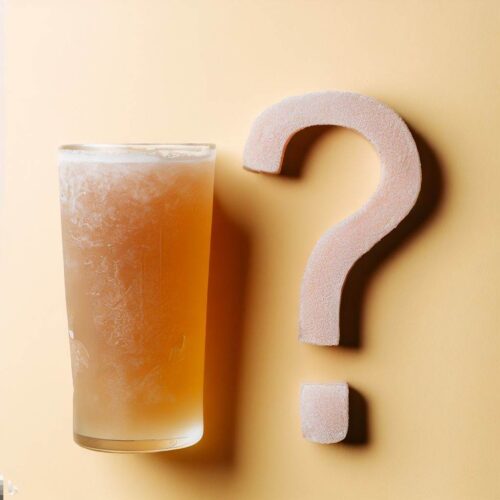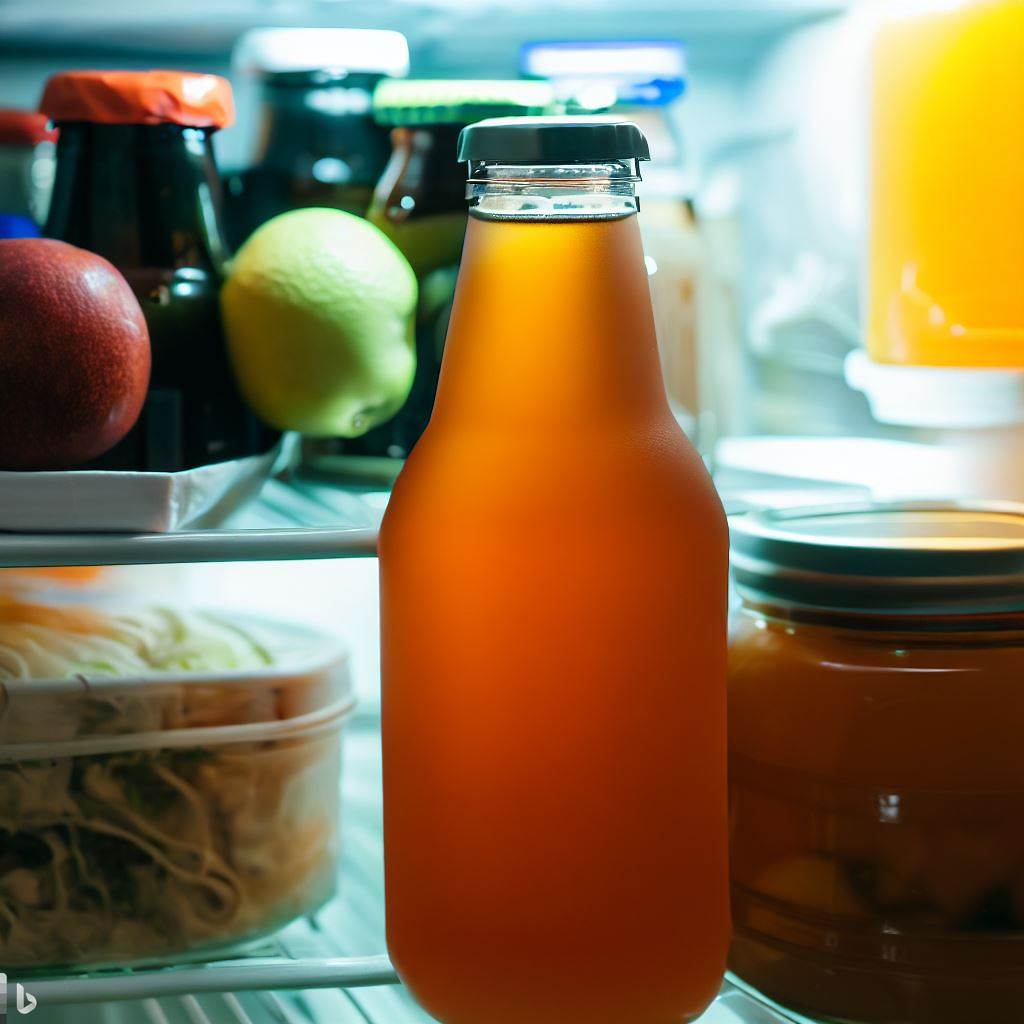How Long Does Kombucha Last?
Outline of Blog Post
- Introduction
- Factors Affecting the Shelf Life
- Determining the Freshness
- Storing for Longevity
- Signs of Spoiled Kombucha
- Extending the Shelf Life
- Frequently Asked Questions (FAQs)
Introduction
Kombucha, is made through the fermentation of sweetened tea using a symbiotic culture of bacteria and yeast (SCOBY). In this blog post, we will explore the intriguing question: how long does kombucha last? To understand the factors that affect its shelf life and how to maximize its freshness, let’s dive into the fascinating world of booch. Lets dive in!

What is Kombucha, also known as Booch?
Kombucha is a fermented tea beverage known for its effervescence, tanginess, and probiotic content. It has been consumed for centuries and is believed to have originated in Northeast China. The primary ingredients in booch are tea, sugar, and the SCOBY, a rubbery disc-like culture. As the SCOBY consumes the sugar during the fermentation process, it produces various organic acids, carbon dioxide, and a trace amount of alcohol, giving booch its distinctive characteristics.
Popular Flavors of Kombucha
Kombucha comes in a wide range of flavors, allowing enthusiasts to find their perfect match. Some popular flavors include:
- Original: The classic “booch” flavor with a balance of tartness and sweetness.
- Ginger: Infused with the zesty warmth of ginger, this flavor adds a spicy twist.
- Berry: A fruity combination of berries, lending a vibrant and refreshing taste.
- Lemon Lavender: A delightful blend of citrusy lemon and soothing lavender.
- Tropical Paradise: A tropical medley of fruits like pineapple, mango, and passionfruit.
Brief History of Kombucha
The origins of kombucha can be traced back over two thousand years to ancient China. It was revered for its detoxifying properties and was known as the “tea of immortality.” From there, booch spread to other parts of Asia and eventually reached Russia and Eastern Europe. In recent decades, its popularity has surged worldwide as more people discover its unique taste and potential health benefits.
Factors Affecting the Shelf Life of your Booch
The shelf life of kombucha can vary based on several factors. Let’s explore the key elements that affect how long booch can last.

Brewing Process
The brewing process plays a significant role in determining the shelf life of kombucha. Factors such as the quality of ingredients, brewing temperature, and fermentation time can impact the final product. A well-brewed booch with a healthy SCOBY is more likely to have a longer shelf life.
Fermentation Time
The duration of fermentation affects both the taste and shelf life of kombucha. Generally, a longer fermentation period produces a more acidic and less sweet beverage. The acidity acts as a natural preservative and helps extend the shelf life. However, excessively long fermentation can result in overly tart booch.
Storage Conditions
Proper storage is crucial for maintaining the freshness of kombucha. Storing it at the right temperature helps slow down the fermentation process and preserve the flavors. Ideally, booch should be refrigerated to inhibit the growth of unwanted microorganisms and maintain its quality.
Ingredients Used
The quality and freshness of the ingredients used in kombucha production can impact its shelf life. High-quality tea, organic sugar, and filtered water contribute to a healthier fermentation process and a longer-lasting product. Moreover, using fresh, ripe fruits or natural flavorings enhances the taste and longevity of booch.
Determining the Freshness of Kombucha
To ensure the freshness of your kombucha, you can assess its appearance, aroma, taste, carbonation level, and pH level. These indicators will give you a good idea of whether your booch is still enjoyable to consume.
Appearance and Color
Fresh kombucha typically has a clear and vibrant appearance. Cloudiness or sediment at the bottom of the bottle is normal, as it may contain yeast or residual SCOBY particles. However, excessive cloudiness or unusual colors, such as dark brown or black, may indicate spoilage.
Aroma and Taste
Kombucha should have a pleasant and slightly acidic aroma. It might remind you of vinegar or tart fruit. If you detect any off-putting or foul smell, it’s a sign that the kombucha may have gone bad. Similarly, the taste should be tangy, slightly sweet, and refreshing. Avoid drinking kombucha with an unpleasant or vinegary taste.
Carbonation Level
The fizziness of kombucha can vary depending on the fermentation process and storage conditions. When you open a fresh bottle, you should hear a satisfying “pop” and experience a lively effervescence. If the booch is flat or lacks bubbles, it may have lost its carbonation, indicating a decline in quality.
pH Level
Kombucha typically has a slightly acidic pH ranging from 2.5 to 3.5. You can use pH test strips or a pH meter to measure the acidity. Higher pH levels may indicate that the booch has undergone excessive fermentation, resulting in a sharp and unpleasant taste.
Storing Kombucha for Longevity
To maximize the shelf life of kombucha and maintain its freshness, proper storage is essential. Here are some tips to help you store your booch effectively:

Refrigeration
Storing kombucha in the refrigerator significantly slows down the fermentation process, extending its shelf life. The cold temperature inhibits the growth of bacteria and yeast, preserving the flavors and carbonation. Always keep booch refrigerated, even if it’s store-bought and pasteurized.
Using Airtight Containers
When storing kombucha, it’s crucial to use airtight containers to prevent exposure to air and contaminants. Glass bottles with airtight caps or swing-top lids are excellent choices. Avoid using metal containers or plastic bottles that can affect the taste and quality of thekombucha.
Avoiding Exposure to Sunlight
Kombucha is sensitive to light, especially sunlight. Ultraviolet rays can degrade the quality and taste of the beverage. Therefore, it’s important to store booch in opaque or dark-colored bottles and keep them away from direct sunlight.
Proper Handling and Hygiene
Maintaining proper hygiene during the brewing, bottling, and serving processes is crucial for the longevity of kombucha. Always use clean equipment and sanitize bottles before use. Avoid cross-contamination by using separate utensils for handling the SCOBY and other ingredients. Practicing good hygiene practices ensures a healthier fermentation process and extends the shelf life of booch.
Signs of Spoiled Kombucha
Despite your best efforts, kombucha can still spoil under certain circumstances. Here are some signs that indicate your booch has gone bad and should be discarded:
Mold Growth
The presence of mold on the surface of your kombucha is a clear indication of spoilage. Mold can appear as fuzzy patches or spots of different colors. If you notice any mold growth, it’s best to dispose of the entire batch to avoid potential health risks.

Foul Smell or Taste
Spoiled kombucha often emits a strong, unpleasant odor reminiscent of vinegar or rotting food. Additionally, it may have a sharp, overly acidic, or off-putting taste. If your booch smells or tastes foul, it’s a sign that it has deteriorated and is no longer safe for consumption.
Excessive Fizziness or Flatness
While kombucha is naturally effervescent, excessive fizziness or the absence of bubbles can be indicators of spoilage. Over-fermentation can lead to excessive carbonation, causing the bottle to become overly pressurized and potentially explode. On the other hand, flat booch may indicate that the fermentation process has halted or the beverage has been improperly stored.
Changes in Color or Texture
Fresh kombucha should maintain its original color and consistency. If you notice significant changes, such as a darkening of color, sliminess, or unusual textures, it’s likely that the booch has spoiled. These changes can be a result of contamination or excessive fermentation.
Extending the Shelf Life of Kombucha
If you want to extend the shelf life of your kombucha or repurpose booch that’s past its prime, here are a few options to consider:

Secondary Fermentation
Performing a secondary fermentation can enhance the flavor and longevity of kombucha. By adding fresh fruits, herbs, or juices to the fermented kombucha and allowing it to undergo a second round of fermentation, you can create new and exciting flavor profiles. This process can also increase the carbonation and acidity, which act as natural preservatives.
Adding Preservatives
If you prefer a longer shelf life for your kombucha, you can consider adding natural preservatives. Some options include adding a small amount of citric acid, vitamin C, or cranberry juice. However, it’s important to note that adding preservatives may slightly alter the taste of the booch.
Freezing Kombucha
Freezing kombucha can help preserve its freshness for an extended period. Ensure that you use freezer-safe containers with some headspace to allow for expansion. When you’re ready to enjoy the frozen booch, thaw it in the refrigerator overnight or at room temperature for a few hours. However, keep in mind that the texture and carbonation may change after freezing and thawing.
Making Kombucha Vinegar
If your kombucha has passed its prime, you can repurpose it into kombucha vinegar. Simply allow the booch to continue fermenting until it transforms into vinegar. booch vinegar has a longer shelf life compared to regular kombucha and can be used in various culinary applications.
Frequently Asked Questions (FAQs)

Can you drink expired booch?
Expired kombucha is not recommended for consumption. As the booch ages, its quality and taste deteriorate, and it may develop harmful bacteria or higher alcohol levels. To ensure your safety and the best taste experience, it’s best to consume booch within its recommended shelf life.
Is it safe to consume homemade booch?
When prepared and stored correctly, homemade kombucha is generally safe to consume. However, it’s important to maintain proper hygiene practices, use high-quality ingredients, and monitor the fermentation process. If you notice any signs of spoilage or have concerns about the safety of your homemade booch, it’s best to err on the side of caution and discard it.
How can I make my booch last longer?
To make your kombucha last longer, ensure that you follow proper brewing and storage practices. Use high-quality organicingredients, maintain cleanliness during the brewing process, refrigerate the finished booch, and handle it with proper hygiene. Additionally, exploring techniques like secondary fermentation or adding natural preservatives can help extend the shelf life.
Does the type of tea used affect the shelf life of my booch?
The type of tea used in kombucha can influence its flavor and fermentation process but has minimal impact on its shelf life. Both black and green teas are commonly used, and the fermentation by the SCOBY will occur regardless of the tea variety. However, certain teas, such as herbal teas or those with added oils, may not provide sufficient nutrients for the SCOBY, resulting in a weaker fermentation process.
Can I store kombucha at room temperature?
While it’s possible to store booch at room temperature for a short period, it’s not recommended for long-term storage. Room temperature can promote further fermentation and potentially lead to excessive carbonation, spoilage, or the growth of harmful bacteria. Refrigeration is the best method to maintain the freshness and quality of booch over an extended period.
Conclusion
Now that you have a better understanding of how long kombucha lasts and the factors that influence its shelf life, you can enjoy this delightful fermented tea with confidence. By paying attention to brewing techniques, storage conditions, and the freshness indicators of booch, you can ensure that each sip is a delightful and refreshing experience. Remember to practice good hygiene and use high-quality ingredients for optimal results. Cheers to enjoying your booch at its peak! Happy Brewing y’all!
Thanks so much for reading this GMK Blog Post on “How Long Does Kombucha Last?”. Read some similar articles here:







